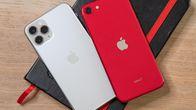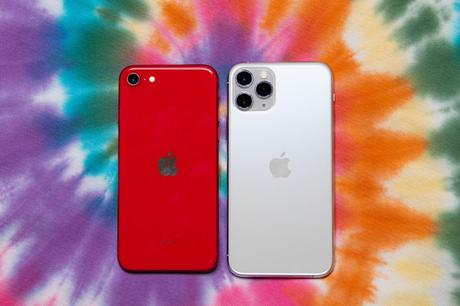the iPhone 11 Pro is undoubtedly the king of Apple's iPhone lineup thanks to its three rear cameras, its all-day battery life and its high-resolution OLED screen. But it is expensive, starting at $ 999 (£ 1,049, AU $ 1,749). With so many new iPhones, including the $ 699 iPhone 11 and the $ 399 iPhone SE, you may be wondering which one to choose. I wanted to compare Apple's flagship product to the economical iPhone to see what a difference it makes $ 600.
Realistically, if you want the high-end iPhone (and it fits your budget), you probably won't even think about the iPhone SE. But as I found out after using both the 11 Pro and the SE for a few weeks, I don't feel like I missed all of that when I switched to the cheaper iPhone.
For more mobile
Subscribe to the Mobile newsletter, receive notifications and view articles on CNET.
Read more: How the $ 399 iPhone SE compares to the $ 11 iPhone 11
Angela Lang / CNET
While the iPhone SE may look like an older iPhone on the outside, make no mistake about it. Combined with the same A13 Bionic chip as that of the iPhone 11 and 11 Pro, it offers excellent performance and a very powerful camera for an entry-level price of $ 399. The battery won't last as long as the more expensive phone, but Apple has made smart compromises to keep the price down.
Read our Apple iPhone SE (2020) review.
Angela Lang / CNET
With an elegant stainless steel chassis, long battery life and a high-resolution OLED screen, the iPhone 11 Pro really feels worthy of the "Pro" label. It's the toughest iPhone you can buy and has three rear cameras that give you flexibility from ultra wide to telephoto. There's also the option to increase the screen size from 5.8 inches to 6.5 if you choose the iPhone 11 Pro Max, and you also get a larger storage option of 512 GB at the upper end, while the iPhone SE shoots at 256 GB.
Read our Apple iPhone 11 Pro review.

The iPhone SE is the most compact, while the 11 Pro is extremely durable
With a 4.7 inch screen, the iPhone SE shares the same overall design as the iPhone 8. That means the home button is back! Or, it never went away if you upgrade something like the iPhone 6 or 7. The iPhone 11 Pro has a 5.8-inch screen and sports the new design of the iPhone without a home button .

Lexy Savvides / CNET
The iPhone SE has an aluminum frame, while the iPhone 11 Pro is made of stainless steel. All Apple phones are covered with custom glass on the front and back, made by Corning, and Apple says the iPhone 11 Pro has the most durable glass of all. I have abandoned the iPhone 11 Pro many times (both in our formal drop test and when used in the past six months) and it has not suffered any significant damage.
Despite this, I still recommend putting a case on your phone just to be sure, because not all drops are created equal. We haven't yet done a durability test on the iPhone SE, but we expect it to perform similarly to the iPhone 8 since it's the same design. (The iPhone 8 suffered a cracked screen when it fell five feet.)
Both phones also offer water resistance, although to slightly different degrees: the iPhone SE is rated IP67, which means it can reach a maximum depth of 1 meter (3 feet) for up to 30 minutes, while the iPhone 11 Pro is IP68, or 4 meters (13 feet) at the same time. But in my extreme water test, I found the iPhone 11 Pro survived much deeper water than Apple claims, so I wouldn't be surprised if the iPhone SE also survived its rating. Anyway, water damage is not covered by the warranty for either phone, so don't go crazy trying to test the limits of your phone (let me !).
Winner: The 5.8-inch iPhone 11 Pro is the perfect size for me, although the iPhone SE is easier to use with one hand.
The iPhone 11 Pro has this magnificent OLED screen
The iPhone SE has a liquid retina LCD screen, while the 11 Pro has an OLED Super Retina XDR screen. There is no doubt that the screen of the 11 Pro is magnificent thanks to a contrast ratio of 2,000,000: 1 and HDR support. Its OLED technology is capable of producing deeper black levels than the LCD screen of the iPhone SE.
That said, I was not disappointed when I switched to the iPhone SE. The colors are precise and the screen is easy to read in bright, outdoor light. In my eyes, watching a movie was more beautiful on the iPhone 11 Pro thanks to a physically larger screen.
Winner: It's hard to compete with the OLED screen on the iPhone 11 Pro.
Touch ID vs Face ID: Home button or facial recognition?
After using the new iPhone SE for several weeks, I am among the many who prefer to use a fingerprint to unlock their phone. Face ID is solid, but has limitations although it becomes more responsive over time. Touch ID works best for me in many situations. Face ID has a hard time recognizing me in the morning after I get out of bed - maybe I'm radically different in the morning, but I really don't think I do. (It is also incompatible with face masks.) Switching to iPhone SE and using my fingerprint to unlock my phone still works.
On the iPhone SE, you sacrifice the screen area to accommodate the home button and I noticed a lot of borders on the SE compared to the almost edge-to-edge screen on the iPhone 11 Pro (same if there is a notch for the TrueDepth camera).
Winner: iPhone SE for transparent tactile identification.
The iPhone 11 Pro has three rear cameras, but do you need them?
There are three rear cameras on the iPhone 11 Pro: ultra wide angle, wide angle and 2x telephoto. The iPhone SE has a single wide rear camera. But as I found by looking at the photos side by side, the difference was not as dramatic as I expected.
The main cameras on both phones use Smart HDR to even out shadows and reflections. The iPhone 11 Pro produced images with greater dynamic range in difficult lighting conditions, but in some photos it was difficult to distinguish them in terms of color and overall processing. The iPhone 11 Pro is equipped with Apple's Deep Fusion processing, which makes it possible to produce sharper photos in medium lighting conditions (think inside). Learn more about how deep fusion works in the great explicator of my colleague Patrick Holland.
You can see the difference that Deep Fusion makes by looking at the same photo on the SE and 11 Pro at full magnification - see the orchid photo below.
Naturally, the iPhone 11 Pro offers greater flexibility when composing your photos thanks to its ultra wide and telephoto lenses. I love the ultra wide perspective and this is the biggest thing I miss when using the iPhone SE.
Also, this camera on the iPhone 11 Pro means you get more flexibility with selfies, like making Animoji and Memoji that mimic your facial expressions and shoot in 4K.
The biggest difference between these two cameras is the night mode - the iPhone 11 Pro has it, while the iPhone SE doesn't. The photos of the 11 Pro are much better in low light than those taken on the SE, because the night mode allows to illuminate the scene and provide a clearer and brighter photo. Stay tuned for my full camera comparison between these two upcoming phones, where I will also cover video recording and selfie cameras.
Winner: iPhone 11 Pro if you want different cameras and night mode.
A13 Bionic chip makes both iPhones incredibly fast
It's no secret that these phones share the same processor and, therefore, I haven't noticed any significant performance differences when used side by side. I ran some benchmark tests on both phones and the results were close, with the 11 Pro outperforming for multi-core performance on Geekbench.
In the real world, both loaded applications are fast and show no noticeable lag when trimming 4K video. In fact, the cheaper OS was a bit faster in my anecdotal test.
Apple does not disclose the official battery capacity for any of its phones, but we do know that the iPhone SE has a battery similar to the iPhone 8. The iPhone 11 Pro, meanwhile, has a higher capacity battery. than the cheaper phone. (Unofficial third party disassembly has revealed that the 11 Pro has a 3,046 mAh battery and 11 Pro Max 3.969mAh.)
There is no doubt that the battery life differs considerably in daily use. The 11 Pro easily got me through a day, sometimes up to a day and a half of fairly intensive use, while the iPhone SE lasted a full day with lighter use. If I watched a video or used the camera a lot, I looked for the iPhone SE charger so I could spend an entire day. Both phones also support wireless charging and fast charging, but only the iPhone 11 Pro comes with an 18-watt quick charger in the box.
Winner: Overall performance looks like a tie, but the iPhone 11 Pro pulls ahead for the battery.
